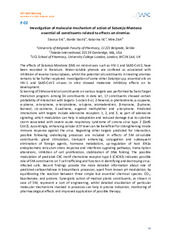Приказ основних података о документу
Investigation of molecular mechanism of action of Satureja Montana essential oil constituents related to effects on viremias
| dc.creator | Erić, Slavica | |
| dc.creator | Vasilić, Đorđe | |
| dc.creator | Ilić, Katarina | |
| dc.creator | Zloh, Mire | |
| dc.date.accessioned | 2023-09-11T13:27:23Z | |
| dc.date.available | 2023-09-11T13:27:23Z | |
| dc.date.issued | 2023 | |
| dc.identifier.uri | https://farfar.pharmacy.bg.ac.rs/handle/123456789/5011 | |
| dc.description.abstract | The effects of Satureja Montana (SM) on retroviruses such as HIV-1 and SARS-CoV2, have been recorded in literature. Water-soluble phenols are confered as associated with inhibition of reverse transcriptases, whilst the potential oil constituents in treating viremias remains to be further explored. Investigation of some other Satureja spp. essential oils on HIV-1 and SARS-CoV2 viruses in vitro showed moderate inhibitory effects on its development. Screening of SM essential oil constituents on various targets was performed by SwissTarget Prediction program. Among 34 constituents in data set, 17 constituents showed certain probability of interaction with targets: 1-octen-3-ol, 2-hexenal, α-phellandrene, α-copaene, α-pinene, α-terpinene, α-terpinolene, α-tujene, aromadendren, β-myrcene, β-pinene, borneol, cis-ocimene, δ-cadinene, eugenol methylethar and γ-terpinene. Predicted interactions with targets include adenosine receptors 1, 2, and 3, as part of adenosine signaling, which modulation can help in adaptation and reduced damage due to cytokine storm associated with severe acute respiratory syndrome of corona virus type 2 (SARS CoV2). Accordingly, enhancing cellular ATP level can be benefitial for strengthening innate immune response against the virus. Regarding other targets predicted for interaction, possible following underlaying processes are included in effects of SM oil-soluble constituents: gland stimulation, transport enhancing, conjugation and subsequent elimination of foreign agents, hormone metabolism, up-regulation of host IER1α endoplasmatic reticulum stress response and interferon sygnaling pathways, transcription alterations, inhibition of cell proliferation, stabilization of DNA folding. The possible modulation of predicted CXC motif chemokine receptor type 3 (CXCR3) indicates possible role of SM constituents on T cell trafficking and function in identifying and destroying virus-infected cells. Recent findings provide the more detailed information about role of predicted carboanhidrase in biosynthesis processes, apart from known pH modulation, by equilibrating the reaction between three simple but essential chemical species: CO2, bicarbonate, and protons. Synergistic action of medical plants constituents, as shown in case of SM, represent a sort of engineering, whilst detailed elucidation of particular molecular mechanisms involved in processes can help in precise indication, monitoring of pharmacological effects and improved application of possible therapy. | sr |
| dc.language.iso | en | sr |
| dc.publisher | International Association of Physical Chemists | sr |
| dc.rights | openAccess | sr |
| dc.rights.uri | https://creativecommons.org/licenses/by/4.0/ | |
| dc.source | 10th IAPC Meeting Tenth World Conference on Physico-Chemical Methods in Drug Discovery & Sixth World Conference on ADMET and DMPK Belgrade, Serbia, September 4-6 | sr |
| dc.title | Investigation of molecular mechanism of action of Satureja Montana essential oil constituents related to effects on viremias | sr |
| dc.type | conferenceObject | sr |
| dc.rights.license | BY | sr |
| dc.citation.spage | 43 | |
| dc.citation.epage | 43 | |
| dc.description.other | 10th IAPC Meeting, Book of Abstracts | sr |
| dc.identifier.fulltext | http://farfar.pharmacy.bg.ac.rs/bitstream/id/13775/Investigation_of_molecular_pub_2023.pdf | |
| dc.identifier.rcub | https://hdl.handle.net/21.15107/rcub_farfar_5011 | |
| dc.type.version | publishedVersion | sr |

